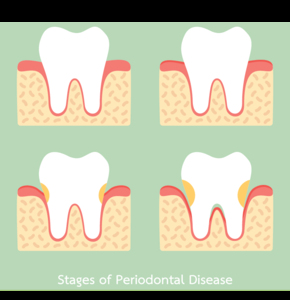
Treating Periodontal Disease
November 12th, 2019
If you or someone you know has just been diagnosed with Periodontal Disease, please start by reading my previous blog on periodontal disease. Once you understand periodontitis, we can discuss how to treat it.
Depending on the severity of your periodontitis, there are surgical and non-surgical treatments for periodontal disease. Non-surgical treatments are much more common.
Non-surgical treatments for periodontal disease
Non-surgical treatment for periodontist is also known as a “deep cleaning, or scaling & root planing (SRP).” I truly like the term “periodontal therapy” best, because it’s an on-going therapeutic cleaning to treat and help prevent future disease.
Normally, periodontal therapy is a service provided by your dental hygienist, and the procedure is not as invasive as periodontal surgery. The therapy procedure involves the gum tissue, alveolar bone and periodontal ligament. The end result of SRP reduces bacteria, as well as hard deposits on teeth and root surfaces. This leads to healthier gum tissue and shrinks the periodontal pocket.
During a periodontal therapy treatment, your hygienist will apply topical anesthetic, which begins the numbing process, and then you will be given local anesthesia to keep you comfortable and allow your clinician to do a thorough procedure. He or she will remove tartar (build up) above and below the gumline. Following the procedure, you may experience light bleeding or post-operative soreness, both of which are normal. You can resume normal eating and drinking the following day.
Periodontal maintenance therapy
Once you’ve had your periodontal therapy, your tissues have healed and the pockets have been reduced—so what’s next? Because periodontal disease can only be controlled but not reversed, periodontal maintenance therapy is next. Patients should see their hygienist every 3-4 months, depending on the amount of bacteria remaining and how quickly the bacteria multiply. The goal of periodontal maintenance is to reduce bacteria, keeping it from causing further damage and to remove plaque and tartar.
By now, hopefully you have plenty of information to understand Periodontal Disease, the treatment of Periodontal Disease, and Periodontal Maintenance. As always, our office is here to guide you through the process. We believe that by educating our patients, they feel more comfortable and receive more positive results. If you should need more information, please don’t hesitate to contact us.




